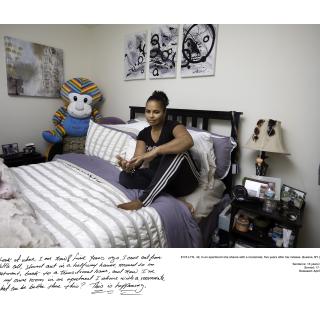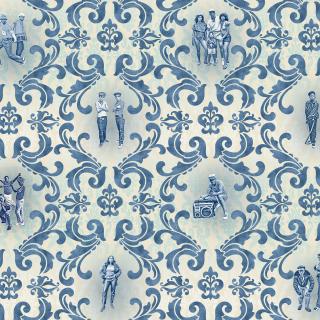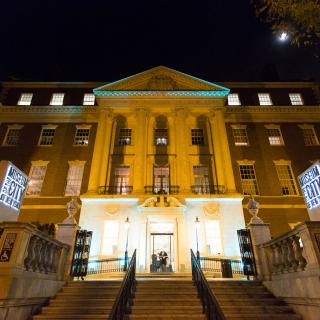New York Now: Introduction

About New York Now: A Photography Triennial
This exhibition launches a new series at the Museum of the City of New York. Building on the legacy of the pathbreaking exhibition New York Now: 2000, every three years the Museum will present a curated show of recent lens-based work. It aims to promote diverse perspectives and to include both established and emerging talents through specific themes of relevance to New York, New Yorkers, and the experience of urban life in the city. The work was selected with the help of an Advisory Committee and the public was invited to submit work for consideration.
All artworks in New York Now: Home are provided by the artist unless otherwise noted.
INTRODUCTION
What does home in New York City look like today? Who fits within a “family photo,” and what counts as “domestic space”? Since its founding in 1923, the Museum of the City of New York has been interested in representing all facets of life in the city, including the changing home and family. A century later, the appearances and compositions of home look radically different than they did in the past, and photographs remain important witnesses to these changes. New York Now: Home, the inaugural edition in the Museum’s new contemporary photography triennial series, features photographs and artworks that reveal the complexities of home in New York’s five boroughs.
Home on the one hand, can be represented through the physical locations that hold our personal lives—houses, apartment buildings, public spaces, even places of worship. But home is equally pictured through the deep connections made among people who call themselves family: families of origin, chosen families, and communities bonded through shared experiences such as race, class, gender, sexuality, immigration status, religion, or ability. With works ranging from social documentary to conceptual, the 33 artists in New York Now: Home reveal the ways that homes cross geographic borders; how homes are havens of safety for some but not all; the joy in homes and families being chosen when they are not inherited; and the experience of homes that are made in our bodies. Together, the images celebrate the diversity of what home, family, kinship, and community are and can be in New York, now.
– Sean Corcoran and Thea Quiray Tagle, Curators
GAIL ALBERT HALABAN
Valentines, East 10th Street, Greenwich Village, New York, 2022
From the series “Out My Window”
ARCHIVAL PIGMENT PRINT
Gail Albert Halaban moved to New York from Los Angeles in 2004. In her words, “I braced myself for feelings of isolation in a congested city. Awakened by my hungry baby, I would spend nights staring out my window. At two in the morning the club crowd reveled below; in the predawn the flower shops would open to begin the day with bouquets of color. At times, in those most intimate of moments with my daughter, I caught people returning my gaze.”
Albert Halaban began the series “Out My Window” as a way of connecting with her neighbors. She seeks out participants to photograph each other through their own windows. Coordinating communication between neighbors, Albert Halaban’s photographs are a form of social engagement that encourage her subjects and the viewers of her photographs to reconsider their homes, their surroundings, and the community they encounter on a day-to-day basis.
GAIL ALBERT HALABAN
My Neighbors, Flower District, Chelsea, New York, 2021
From the series “Out My Window”
ARCHIVAL PIGMENT PRINT
IRINA ROZOVSKY
Untitled
From the series “In Plain Air, Prospect Park, Brooklyn,” 2011–2013
ARCHIVAL PIGMENT PRINTS
Real estate is always at a premium in New York City. Given the often-minuscule size of private apartment spaces, public spaces—and particularly parks— are often considered New Yorkers’ secondary living spaces. In Brooklyn, Prospect Park is the borough’s central park, designed and constructed over a 30- year period (1865–1895) by Frederick Law Olmsted and Calvert Vaux. It is a place of gathering and respite for the many diverse communities that live in its vicinity.
From 2011 until 2020, Irina Rozovsky photographed the people who use the park as their backyard throughout the four seasons. With the park’s environment providing an often-idyllic backdrop, the scenes are sometimes solitary and sometimes communal. Rozovsky’s beautifully lit color photographs concentrate on meditative moments of relaxation and calm, the solace we find in our companions and in nature.
ALAN MICHELSON
Mespat, 2001
TURKEY FEATHERS, MONOFILAMENT, AND STEEL
RUN TIME: 19:24 MINUTES
Newtown Creek, the estuary dividing Brooklyn and Queens, was first known as “Mespat” (bad water place) to the indigenous Lenape people, who were violently displaced from the area in 1642 by the first settlers in Queens. Since then, Newtown Creek has been devastated by industrialization. Beginning in the 1800s, raw sewage and industrial runoff began to pollute the estuary, and in the 1950s, it was the site of a 17-million-gallon oil spill. In 2010, the waterway was designated by the US Environmental Protection Agency (EPA) as a Superfund site.
Mohawk artist Alan Michelson revisits this place in his eponymous video installation that pans continuously along its three-and-a-half-mile shoreline. Mespat intentionally evokes moving panoramas—a popular pre-cinematic form of 19th century entertainment in which exotic landscapes painted on long scrolls of canvas were unspooled for audiences, fostering the illusion of maritime travel. Mespat is a critical meditation on the interrelation- ships between settler colonialism and Indigenous displacement, environmental degradation, and landscape representation.
MAUREEN R. DRENNAN
1. Shannan, 2013
2. Ed’s Egret, 2015
3. Chelsie, 2014
4. Mayor Al, 2012
5. Canal, 2013
ARCHIVAL PIGMENT PRINTS
Maureen R. Drennan began photographing in Broad Channel, Queens in 2012. On the only inhabited island in Jamaica Bay, she encountered a small, tightknit, mostly working-class community of some 3,000 people with a lifestyle akin to that of a fishing village. The community is approximately 20 blocks long and four blocks wide, and is surrounded by Jamaica Bay Wildlife Refuge. There, life is intertwined with natural surroundings, deeply connected to the water: people typically own a boat and fish and swim off their own private docks.
As Drennan began her work in the months before Superstorm Sandy, she came to understand the complex relationship between the community and place in Broad Channel. Drennan wanted to examine the “enduring fantasy of living near the water that is in direct opposition to the reality. The residents love living by the water and are defined and enriched by it, but there exists a delicate balance between the community and the natural environment. As the effects of climate change shake this balance, the inhabitants have been confronted with the harsh reality that their home and community may not be as secure and idealistic as they think it to be."
ROY BAIZAN
1. Mrs. Judy, 2018
2. Mutual Aid, 2020
3. Gentrification of Mott Haven, 2022
4. 136th & Willis Avenue, 2021
5. 138th & Brown Place, 2021
6. 138th & Brook Avenue, 2021
7. 135th & Lincoln Avenue, 2021
8. Fatherhood, 2018
From the series “Mott Haven”
GELATIN SILVER PRINTS
Mott Haven is a waterfront neighborhood in the South Bronx that has undergone multiple waves of urban redevelopment for over two centuries, from Jordan Lawrence Mott’s founding his iron works factory there in 1828 to the construction of 17 public housing developments beginning in the 1970s. Throughout its history, the industrial pollution and economic disinvestment in the area have disproportionately impacted people of color, who created strong community bonds in spite of—or sometimes because of—the injustices they faced. Today, Mott Haven is under siege from real estate developers who seek to build new condominiums along the waterfront, displacing thousands of residents in the process. And yet the residents resist.
Bronx-raised Mexican photographer and educator Roy Baizan’s “Mott Haven” series focuses its attention on the working-class residents of Mott Haven, not to document them before they disappear, but to illuminate their resilience in the face of massive change. His photographs map Mott Haven’s built and natural environments alongside its true anchors— the Black and Latinx families who live, work, and play on the waterfront—and call for viewers’ solidarity against gentrification.
IAN REID
Farragut Houses, 2018
RUN TIME: 01:22 MINUTES
RUN TIME: 01:17 MINUTES
Ian Reid lived in Farragut Houses at a very early age, his family later moved to Fort Greene. Farragut Houses were built by the New York City Housing Authority (NYCHA), created in 1934 to provide affordable housing for low- and moderate-income New Yorkers throughout the five boroughs. These new buildings were meant to offer opportunity as a potential springboard to a better future, but they also disrupted communities and often segregated poor populations. Today, NYCHA houses more than 560,000 city residents, more than 90% of them Black and Latinx, and are derided as “projects” as shorthand for housing crime and poverty.
Since 2018, Reid has chosen to photograph 23 NYCHA developments in Brooklyn, including the Farragut Houses. He has used drones to create still and video footage that seeks to document and present them “as the structures they are without the preconceived notions of what goes on inside them.” In these short videos, we see street views of the Farragut Houses surrounded by multi-million-dollar apartments in DUMBO and the Lower Manhattan skyline. We also follow Reid’s first-person view as he enters the building his family lived in and walks to an apartment door similar to the one he called home. As Reid observes, “Gentrification and development have changed the surroundings of the public housing, but the buildings and the residents for the most part stay the same.”
ELIAS WILLIAMS
1. Tony Timms and the Rock, St. Albans, Queens, 2014
2. Gregson and Bridgette Smith at Home, St. Albans, Queens, 2019
3. Grandma’s Couch, St. Albans, Queens, 2016
ARCHIVAL PIGMENT PRINTS
The first 15 years of Elias Williams’ life was spent in St. Albans, a community tucked into the southwest corner of Queens. For about a century, St. Albans has been a place where Black home and business ownership has flourished. Predominantly an African American and Caribbean American working and middle-class neighborhood, the community has been home to such notable figures as civil rights activist W.E.B. DuBois, jazz musicians including Count Basie, John Coltrane and Lena Horne, and iconic sports figures including Jackie Robinson and Joe Louis.
Williams returned, spending more than a decade to create a portrait of the community as it dealt with the aftereffects of the housing crisis, which he says, “struck heavily in St. Albans and transformed the community into an epicenter of mortgage fraud. In 2007, Black communities throughout New York City were targeted by banks with predatory loans nearly seven times as high as loans in affected white communities. While the effects of the housing crisis still linger, the soul of this community persists.” This series “celebrates the pride of St. Albans in the midst of economic hardship, preserving the identity of one of New York City’s historically Black communities."
Image Credit: Gail Albert Halaban, Valentines, East 10th Street, Greenwich Village, New York, 2022. Courtesy of the artist.






